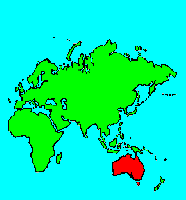SPECIES INFO
The Taipan or northern Taipan (Oxyuranus scutellatus) is found in the lowlands of northern and north eastern Australia. This is also found in New Guinea. This is found from north eastern Western Territory through the northern part of the Northern Territory and along the lowlands of Queensland to north eastern New South Wales. This snake can reach over 6 feet in length. This snake can be pale or dark, but is usually somewhat evenly colored. This is considered a very dangerous venemous snake.Taipan genus (Oxyuranus) has two species both of which are found in Australia. One species has a range that extends into New Guinea. These snakes are known to reach over 8 feet in length. Both are considered among the most dangerous snakes in the world.
The cobra family (Elapidae) has a very large number of species in the New Guinea and Australia region. Wilson and Swan note there are about 90 described species in this family found in Australia alone. In cooler areas these are live bearing, and it tropical areas these species tend to lay eggs.
Cobra and Coral Snake Group (Family Elapidae) is known for its deadly poisons. Some of the snakes in this group are small and not dangerous unless handled, stepped on, or disturbed. However, their venom is very deadly and they should all be considered potentially dangerous. There are almost 300 species in this family. The mambas, tiger snakes, and kraits also belong here. Australia has about 90 of these species.
Lizards and Snakes (Squamata Order) share many common characteristics and consequently they are grouped in a single order. There are greater differences between some groups of lizards than there are between other groups of lizards and snakes. The same is true of snakes. Lizards and snakes share a common skull shape.
There are perhaps 4,000 species of lizards and perhaps 2,700 species of snakes alive today. In the Great Big Book of Snakes and Reptiles published in 2014, they noted the above estimates.
Reptiles (Class Reptilia) are an ancient group of scaled chordates. These scales may be permanently joined, as in the turtles, or flexible, as in the snakes. Reptiles are land-based. Their eggs are laid on land and the young are air breathing.
In the Great Big Book of Snakes and Reptiles published in 2014, they noted that there are more than 7,000 species of reptiles alive today.
Backboned Animals (Phylum Chordata) are the most advanced group of animals on earth. These animals are characterized by having a spinal cord or backbone. Most members have a clearly defined brain that controls the organism through a spinal cord. Fish, amphibians, reptiles, birds, and mammals are in this phylum.
Currently, some taxonomists believe that the fish should be divided into two groups (sharks and regular fishes) and that there are some other primitive groups in the phylum such as hagfish or lampreys.
Animal Kingdom contains numerous organisms that feed on other animals or plants. Included in the animal kingdom are the lower marine invertebrates such as sponges and corals, the jointed legged animals such as insects and spiders, and the backboned animals such as fish, amphibians, reptiles, birds, and mammals.

